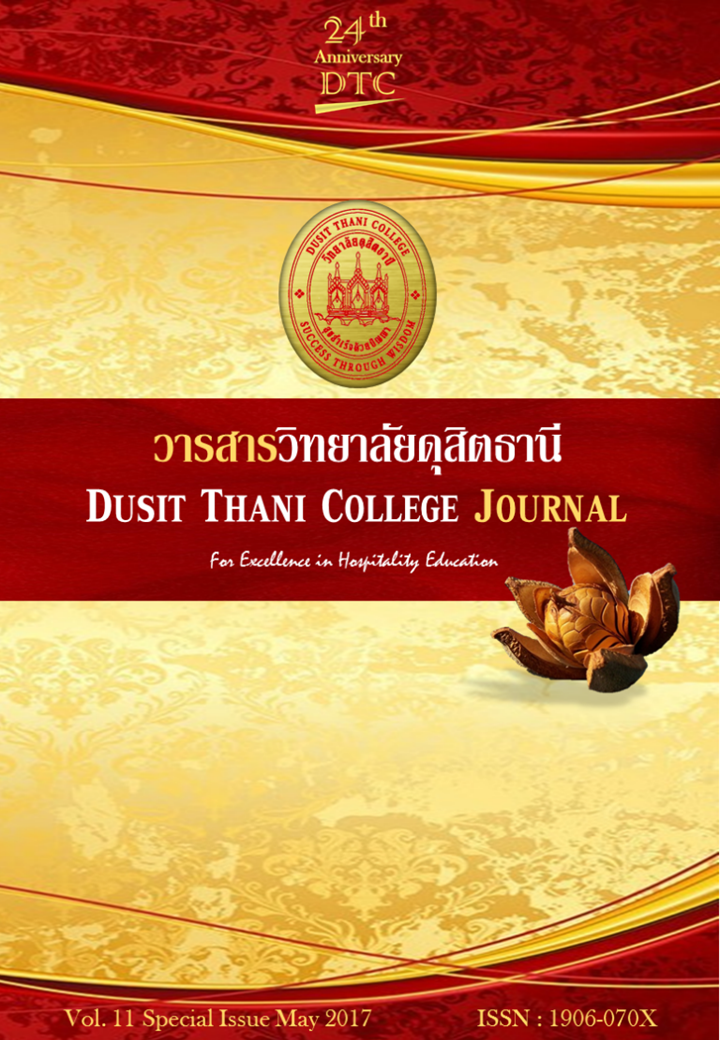Development of Ecotourism Attraction Standards in Thailand
Main Article Content
Abstract
This research aimed to assess ecotourism attraction standards and to propose development guidelines for ecotourism attractions in Thailand. This research was a qualitative research. Fifty-three in-depth interviews were conducted by purposing sampling from key informants including the representatives from related public sector, private sector, community and educational institutes. Moreover, the focus groups of eighty-five key informants were conducted to assess ecotourism attraction standards in six selected national parks in Thailand. Content analysis, strength and weakness analysis and standard scoring were used to analyze data. The result found that the grand total scores of six national parks were at a very good level. Kaeng Kachan National Park received the highest score, followed by Doi Intanon, Khaoyai, Khaosok, Mukoh Surin, and Kuiburi National Parks respectively. Finally, the research guidelines for the public sector, private sector and the communities for developing ecotourism attraction standards including development of ecotourism policy and master plan for Thailand, enforcement of ecotourism attraction standards, education and development of conservation consciousness among stakeholders, management of ecotourism attraction facilities, and marketing and public relations for ecotourism attractions.
Article Details
Article Screening Policy
- All research and academic articles to be published must be considered and screened by three peer reviews in the relevant field / article.
- All articles, texts, illustrations and tables published in the journal are the personal opinions of the authors. Editors don't always have to agree. And no responsibility whatsoever is the sole responsibility of the author.
- The articles to be published must never be published. Where did you first publish? And not in the consideration of other journals If the audit found that there has been a duplicate publication It is the sole responsibility of the author.
- Any article that the reader sees as being plagiarized or impersonated without reference. Or mislead the work of the author Please let the journal editor know it will be your greatest blessing.
References
Dasri, Prayun. (2012). Destination Quality Standard Survey for Pang-Si-Da National Park, Srakaew Province. Journal of International and Thai Tourism, 10(2): 14-31.
Department of Tourism. (2015). Tourist Statistic in 2013. Retrieved from
https://www.tourism.go.th/home/details/11/221/621
Department of Tourism. (2015). Tourist Statistic in 2015. Retrieved from
https://www.tourism.go.th/home/details/11/223/622
Department of Tourism. (2016). Manual Evaluation of Quality Standard for Ecotourism Attractions. Bangkok: Ministry of Tourism and Sports.
Diamantis, D. Ecotourism: Management and Assessment. London: Thomson. 2004.
Fennell, D. Ecotourism: An Introduction. London: Routledge.1999.
Kotsombat, Krit. (2010). Assessment of the Ecological Tourism Potential: A Case Study of Tourist Sites of Sam Panbok in Phosai District of Ubon Ratchathani Province. (Unpublished Master Thesis). Ubon Ratchathani Rajabhat University, Thailand.
Luenshavee, Apinya. (2004). Law Enforcement in Ecotourism Attraction Management: A Case Study of National Park. Bangkok: Dhurakij Bandit University.
National Economic and Social Development Board. (2012). The Eleventh National Economic and Social Development Plan (2012-2016). Bangkok: National Economic and Social Development Board.
Office of the National Economic and Social Development Board. (2013). Sustainable Ecotourism on Green Line: A Case Study of North Eastern Regions. Bangkok: Office of Economic and Social Development.
Pongwiritthon, Ratthanan, and Pakvipas, Pakphum. (2014). The guideline for development of strategies to raise the standards of natural attractions in Chiang Mai: A case study of Doi Inthanon National Park. Journal of Community Development Research, 7(1): 44-55.
Suchaya, Wattanaporn. (2002) Guidelines for Tourism Site Management in Accordance with the Principles of Ecotourism: A Case Study of Doi Tung in Chiang Rai Province. (Unpublished Master Thesis). Chiang Mai University, Chiang Mai, Thailand.
Thailand Institute of Scientific and Technological Research. (1997). Policy Formulation for Ecotourism. Bangkok: n.p.


